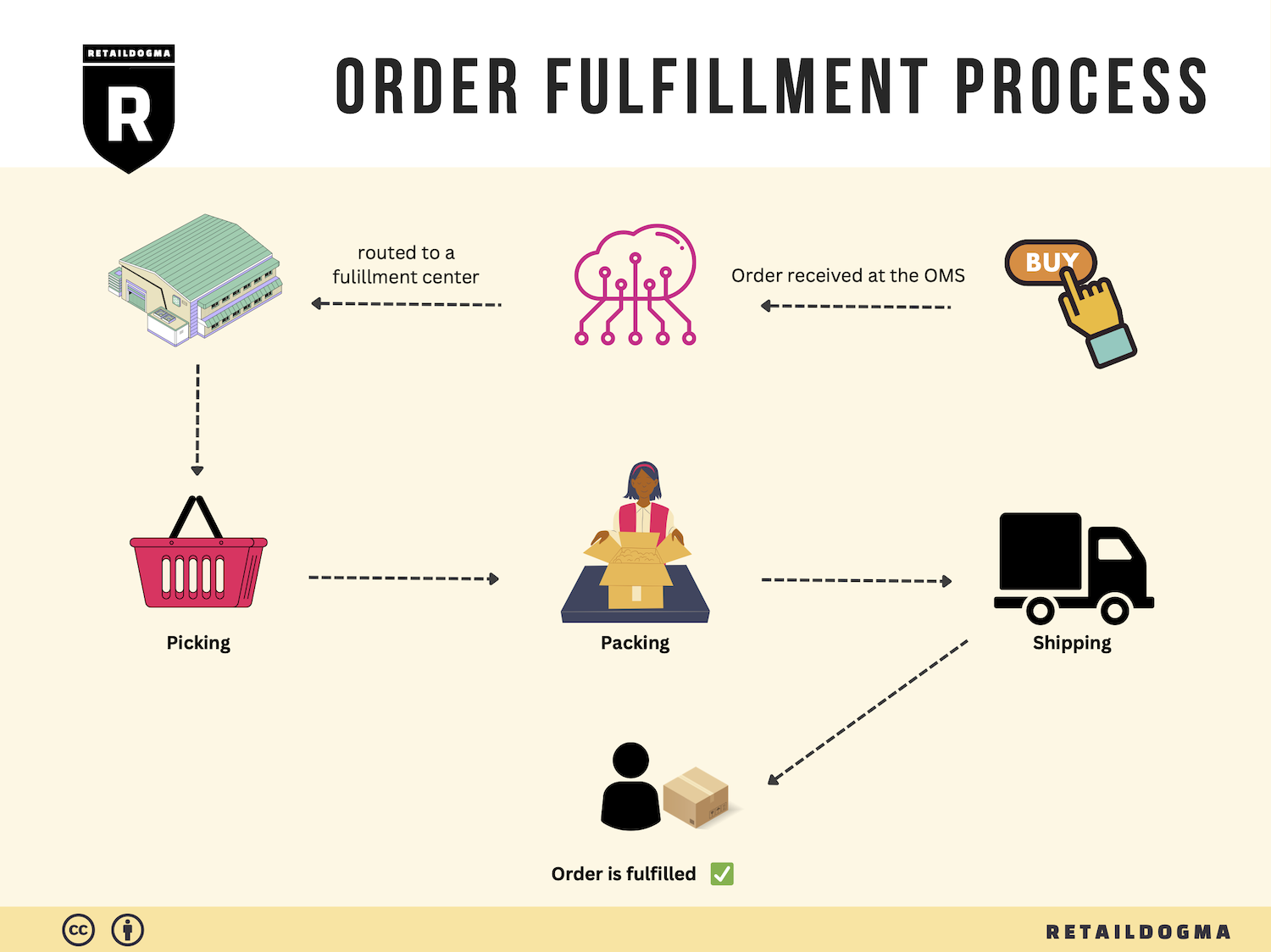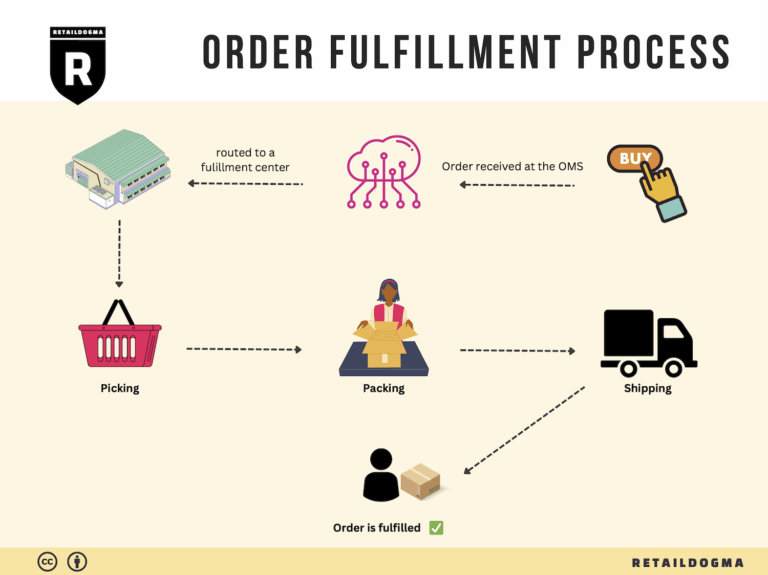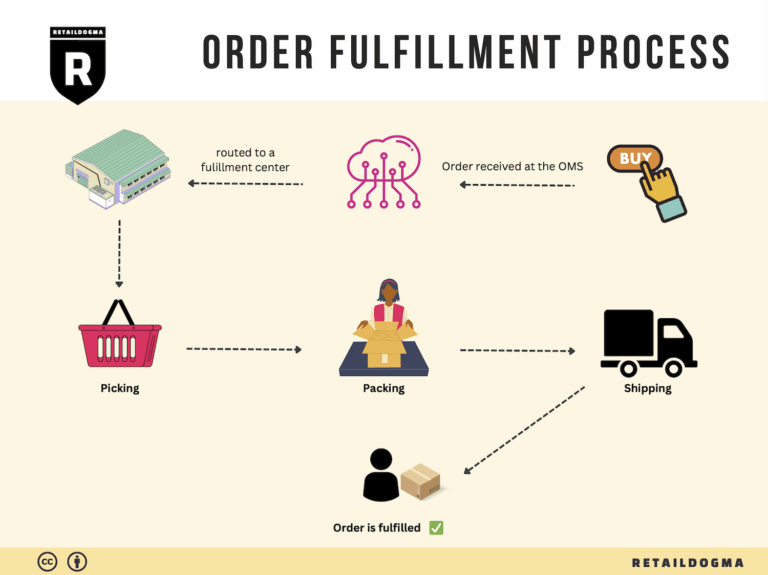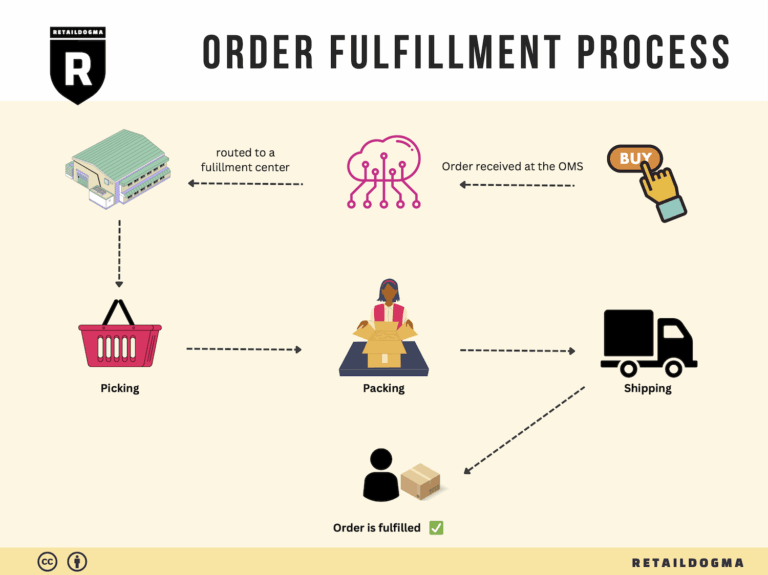What Is A Fulfillment Center? A Complete Guide (2025)
What is E-commerce Fulfillment? An Introduction for Growing Businesses
Understanding E-commerce Fulfillment: A Crucial Element for Growth
As an e-commerce business owner, you may find yourself facing a daunting challenge: the overwhelming task of packing and shipping orders. Managing logistics can quickly become a significant burden, diverting your focus from growth and customer engagement. This is where understanding e-commerce fulfillment becomes essential. Fulfillment, in its simplest form, is the process of getting a product from your warehouse or supplier directly to your customer’s doorstep. It encompasses everything from inventory management to order processing, packaging, shipping, and handling returns.
In this guide, we will explore various fulfillment models available to e-commerce businesses, including Third-Party Logistics (3PL) and Fulfillment by Amazon (FBA). Each model has its unique benefits and challenges, and understanding them will help you align your fulfillment strategy with your business objectives.
Core Services of E-commerce Fulfillment
E-commerce fulfillment involves several core services that are crucial for operational efficiency. These include:
- Inventory Management: Keeping track of stock levels, managing reorders, and ensuring product availability.
- Order Processing: Quickly and accurately processing orders as they come in, which includes picking, packing, and shipping.
- Shipping: Selecting the best shipping methods and carriers to ensure timely delivery at competitive rates.
- Returns Management: Handling returns efficiently to maintain customer satisfaction and manage restocking.
Choosing the Right Fulfillment Partner
Selecting the right fulfillment partner is a critical decision for any growing business. Factors to consider include their capabilities, technology integration, customer service, and pricing structures. A good partner should not only meet your current needs but also scale with your business as it grows.
Understanding Pricing Structures
Pricing can vary widely between different fulfillment services, so it’s crucial to understand how costs are calculated. This includes storage fees, picking and packing fees, shipping rates, and any additional charges that may apply. Knowing these details can help you make informed decisions and avoid unexpected expenses.
Empowering Your Business Through Smart Logistics Decisions
The primary goal of this guide is to empower you, the business owner, to make informed decisions about your logistics strategy. By understanding the intricacies of e-commerce fulfillment, you can streamline your operations, enhance customer satisfaction, and ultimately scale your business efficiently. As you navigate this complex landscape, remember that the right fulfillment strategy can be a significant driver of your e-commerce success.
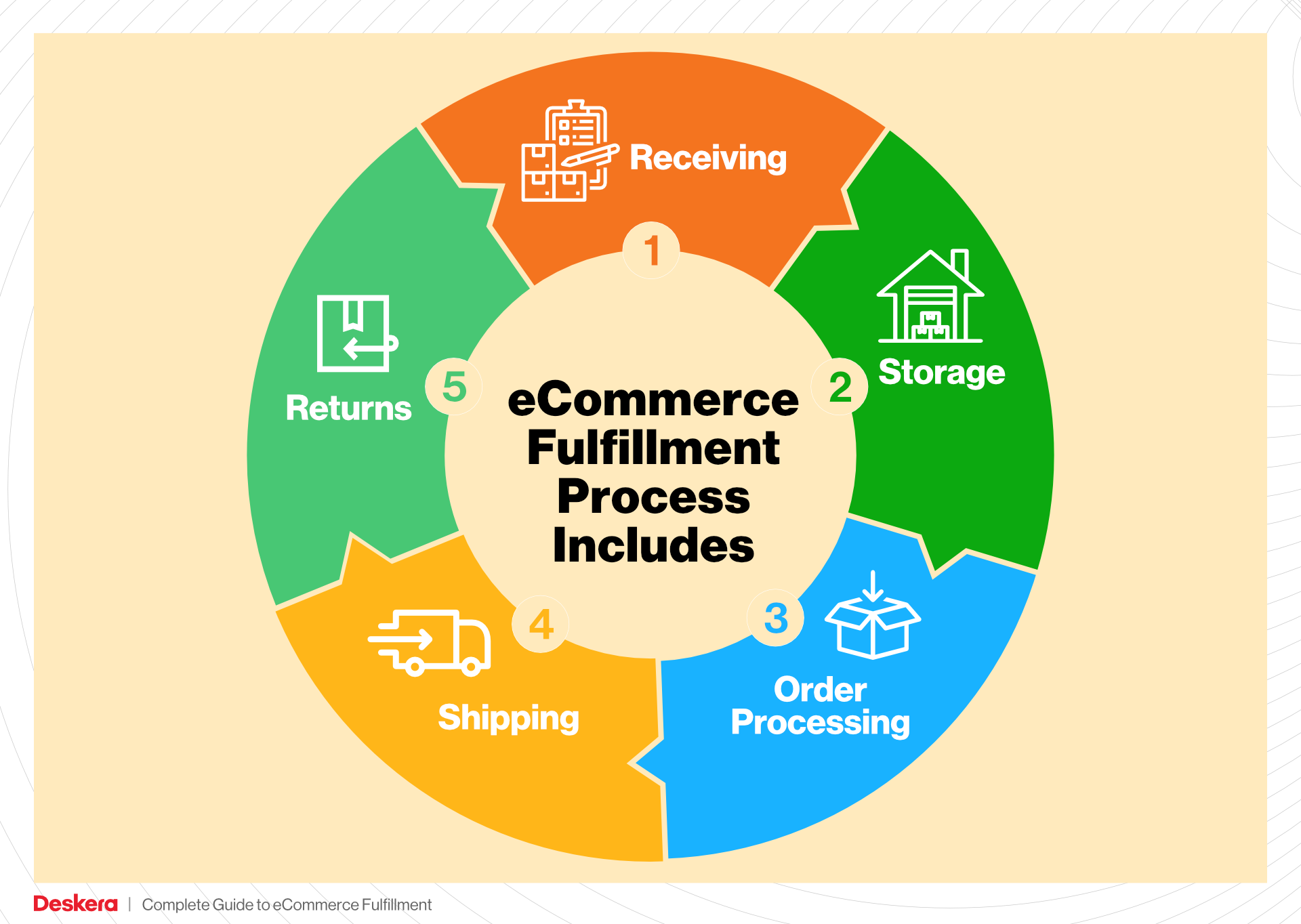
What You’ll Learn In This Guide
- What is E-commerce Fulfillment? An Introduction for Growing Businesses
- The Order Fulfillment Process: From ‘Buy’ Button to Customer’s Door
- Comparing Fulfillment Models: In-House vs. 3PL vs. Dropshipping
- A Deep Dive into Amazon FBA: Pros, Cons, and Who It’s For
- Core Services Offered by Fulfillment Centers
- How to Choose a Fulfillment Partner: A 6-Point Checklist
- Understanding Fulfillment Pricing: A Breakdown of Common Fees
- Frequently Asked Questions (FAQs) about Fulfillment
- Conclusion: Is Outsourcing Fulfillment the Right Move for Your Business?
- Important Disclaimer
The Order Fulfillment Process: From ‘Buy’ Button to Customer’s Door
1. Receiving Inventory
The order fulfillment process begins with receiving inventory from suppliers or manufacturers. This step involves checking the incoming shipments against purchase orders to ensure accuracy in terms of quantity and product specifications. Each product is assigned a unique Stock Keeping Unit (SKU), which serves as an identifier for tracking and managing stock levels.
Importance: Proper inventory receiving is crucial for maintaining accurate inventory records and preventing stock discrepancies. If items are not received correctly, it can lead to stockouts or overstock situations, adversely affecting customer satisfaction and operational efficiency.
Key Term: SKU (Stock Keeping Unit) – A unique identifier for each distinct product and service that can be purchased.
2. Warehouse Storage
Once inventory is received and verified, it is stored in the warehouse. Efficient storage involves organizing products in a way that maximizes space and streamlines access. This may include utilizing shelving systems, bins, and pallets. Warehouse management systems (WMS) often assist in tracking the location of each SKU within the facility.
Importance: Effective warehouse storage is vital for speeding up the order fulfillment process. A well-organized warehouse reduces the time taken to locate products, which directly impacts order processing times. Additionally, it helps in maintaining an optimal inventory level, thereby reducing carrying costs.
Key Term: Warehouse Management System (WMS) – Software that supports the daily operations of a warehouse, including inventory tracking and location management.
3. Order Picking
When a customer places an order, the next step is order picking, where warehouse staff retrieve the ordered items from their storage locations. This process can be done manually or through automated systems, and it often involves using pick lists—documents that outline the items and quantities needed for each order.
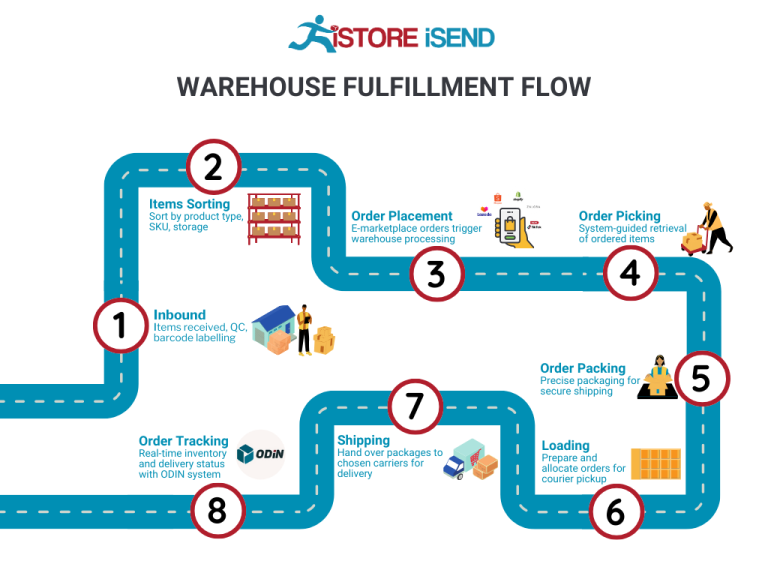
Importance: Order picking is a critical step as it directly influences order accuracy and fulfillment speed. Errors during picking can lead to incorrect shipments, resulting in returns and customer dissatisfaction. Efficient picking methods, such as batch picking or zone picking, can significantly enhance productivity.
Key Term: Pick List – A document or digital notification that lists the items and quantities to be picked for a specific order.
4. Order Packing
After picking, the next step is order packing. This involves placing the items into appropriate packaging to ensure they are protected during transit. Packing materials, such as bubble wrap, packing peanuts, and custom boxes, are used to safeguard products. Shipping labels are printed at this stage, often integrated with order management systems to streamline the process.
Importance: Proper packing is essential to prevent damage during shipping, which can lead to costly returns and replacements. Additionally, well-packed orders can enhance the unboxing experience for customers, contributing to brand loyalty.
Key Term: Shipping Label – A label that includes crucial information such as the destination address, tracking number, and return information, facilitating smooth transit.
5. Shipping & Delivery
The final step in the order fulfillment process is shipping and delivery. Once an order is packed, it is handed over to a carrier for delivery. Businesses often have partnerships with multiple carriers to find the most cost-effective and efficient shipping options. Tracking information is usually provided to customers, allowing them to monitor their order’s journey.
Importance: Timely shipping and delivery are key to customer satisfaction. The speed and reliability of shipping can significantly influence repeat purchases and overall brand perception. By optimizing shipping routes and using reliable carriers, businesses can improve their fulfillment performance.
Key Term: Tracking Information – A unique code that allows customers to track the status and location of their shipment throughout the delivery process.
By understanding and optimizing each step of the order fulfillment process, e-commerce businesses can enhance their operational efficiency, reduce costs, and improve customer satisfaction, ultimately driving growth and scalability.
Comparing Fulfillment Models: In-House vs. 3PL vs. Dropshipping
Fulfillment Model Comparison Table
| Model | Who Handles Inventory | Best For (Business Stage) | Key Advantage | Key Disadvantage |
|---|---|---|---|---|
| In-House Fulfillment | The e-commerce business itself | Established businesses scaling up | Full control over inventory and operations | Higher overhead costs and complexity |
| Third-Party Logistics (3PL) | External logistics provider | Startups and growing businesses | Access to expertise, scalability, and cost-efficiency | Less control over inventory and potential delays |
| Dropshipping | Supplier or manufacturer | New or small businesses | Low upfront investment and minimal risk | Lower profit margins and dependency on suppliers |
In-House Fulfillment
In-house fulfillment is a model where the e-commerce business manages its inventory and shipping operations. This approach provides businesses with complete control over their products, allowing for customized packaging, branding, and a deeper understanding of inventory management. For established businesses that are scaling, in-house fulfillment can be advantageous as it enables them to fine-tune their logistics processes to match their specific needs and customer expectations.
However, managing fulfillment in-house comes with its challenges. The overhead costs can be significant, especially related to warehousing, staffing, and technology. Businesses must invest in systems for inventory management, shipping label printing, and order tracking. Additionally, the complexity of managing logistics can divert focus from core business activities, such as marketing and product development, potentially stalling growth if not handled efficiently.
Third-Party Logistics (3PL)
Third-party logistics (3PL) involves outsourcing fulfillment operations to an external provider. This model is particularly beneficial for startups and growing businesses that may not have the resources to manage logistics in-house. 3PL providers offer a range of services, including warehousing, order processing, inventory management, and shipping. By leveraging a 3PL, businesses can access industry expertise, advanced technology, and scalable solutions that adapt to their growth.
One of the key advantages of using a 3PL is the cost-efficiency it can offer. These providers often have established relationships with shipping carriers, enabling them to negotiate better rates, which can translate to lower shipping costs for businesses. However, a major downside is the loss of direct control over inventory and fulfillment processes. This can lead to potential delays and miscommunication, especially if the 3PL does not align well with the business’s operational standards. Moreover, businesses must ensure they choose a reliable 3PL partner to mitigate risks associated with order accuracy and customer satisfaction.
Dropshipping
Dropshipping is a fulfillment model where the retailer does not hold inventory but instead transfers customer orders to a supplier, who then ships the products directly to the customer. This model is particularly well-suited for new or small businesses due to its low upfront investment requirements. Entrepreneurs can set up an online store without the burden of managing inventory or fulfillment logistics, allowing them to focus on marketing and sales.
The primary advantage of dropshipping is the minimal financial risk involved. Since retailers only purchase inventory after a sale is made, there is no need for significant capital investment in stock. However, dropshipping comes with its own set of challenges. Profit margins tend to be lower compared to other models, as retailers must account for the supplier’s markup. Additionally, businesses are heavily reliant on their suppliers for product quality, shipping speed, and accuracy, which can affect customer satisfaction. In cases where suppliers fail to meet expectations, the retailer bears the brunt of customer complaints, potentially damaging their brand reputation.
Conclusion
Choosing the right fulfillment model is critical for e-commerce success, particularly in the context of stamp fulfillment services, where precision and reliability are paramount. Businesses must evaluate their current stage, resources, and long-term goals when selecting between in-house fulfillment, third-party logistics, or dropshipping. Each model has its unique advantages and disadvantages, and the optimal choice will depend on individual business needs, customer expectations, and operational capacity. By carefully considering these factors, e-commerce business owners can position themselves for scalable growth and enhanced customer satisfaction.
A Deep Dive into Amazon FBA: Pros, Cons, and Who It’s For
What is Fulfillment by Amazon (FBA)?
Fulfillment by Amazon (FBA) is a service offered by Amazon that allows e-commerce sellers to store their products in Amazon’s fulfillment centers. Amazon then takes care of the storage, packaging, shipping, and customer service for these products. This service is particularly appealing for businesses looking to streamline their logistics and enhance their customer service capabilities without the overhead costs associated with managing their own warehouse and fulfillment operations.
When a customer places an order for a product listed under FBA, Amazon handles the entire transaction process. This includes picking the product from the warehouse, packing it, and shipping it directly to the customer. Additionally, FBA products are eligible for Amazon Prime and other Amazon services, which can significantly enhance their visibility and appeal to consumers.
How FBA Works
-
Setting Up FBA: Sellers begin by creating an Amazon Seller account and selecting the FBA option. They then prepare their products according to Amazon’s guidelines and ship them to Amazon’s fulfillment centers.
-
Product Storage: Once the products arrive at the fulfillment center, Amazon stores them until they are sold. Sellers can track their inventory levels through their Seller Central dashboard.
-
Order Fulfillment: When an order is placed for an FBA product, Amazon picks, packs, and ships the item directly to the customer. This process is typically very efficient, allowing for quick delivery times.
-
Customer Service and Returns: Amazon also handles customer inquiries and product returns for FBA items, providing a seamless experience for both sellers and customers.
Pros of Fulfillment by Amazon (FBA)
-
Prime Eligibility: Products fulfilled by Amazon are automatically eligible for Amazon Prime, which can greatly increase sales. Prime members often prefer items that can be shipped quickly and free of charge.
-
Customer Trust: Leveraging Amazon’s reputation can enhance buyer confidence. Many customers trust Amazon for their purchasing decisions, and having products fulfilled by Amazon can increase the likelihood of a sale.
-
Multi-Channel Fulfillment: FBA is not limited to Amazon sales. Sellers can use Amazon’s fulfillment services to ship products sold on other platforms, such as eBay or their own e-commerce sites. This flexibility can help streamline operations for businesses with diverse sales channels.
-
Scalability: FBA allows sellers to scale their business without the need for significant investment in logistics infrastructure. As sales increase, Amazon can handle the increased volume without requiring sellers to increase their operational burden.
-
Time Savings: By outsourcing fulfillment to Amazon, sellers can focus on other critical aspects of their business, such as marketing and product development, rather than worrying about logistics.
Cons of Fulfillment by Amazon (FBA)
-
High Fees: While FBA can save time, it comes at a cost. Sellers must pay various fees, including storage fees for their inventory and fulfillment fees for each order processed. These costs can add up quickly, especially for low-margin products.
-
Strict Inventory Rules: Amazon has specific requirements for inventory management. Sellers must adhere to strict guidelines regarding product preparation and packaging, which can be time-consuming and may lead to penalties if not followed.
-
Commingling Risks: When products are stored in Amazon’s warehouses, they may be commingled with inventory from other sellers. This can lead to issues if a seller’s product is defective or if there are complaints about a product that is not theirs. Sellers may receive negative reviews based on the quality of another seller’s product.
-
Limited Control: By relying on Amazon for fulfillment, sellers lose some control over the customer experience. Issues like shipping delays or product handling can impact a seller’s reputation, even if they are not directly responsible.
-
Potential for Overhead: Depending on sales volume, sellers may face significant overhead costs due to storage fees, particularly during slow sales periods when inventory is not moving quickly.
Who is FBA Best For?
Fulfillment by Amazon is particularly well-suited for:
-
Small to Medium-Sized Businesses: Businesses that are scaling and need to streamline their logistics without heavy investment in warehousing may find FBA an ideal solution.
-
Sellers with High Sales Volume: Businesses that expect to sell products consistently can benefit from the efficiency and reliability of Amazon’s fulfillment services.
-
E-commerce Startups: New sellers looking to quickly enter the market and leverage Amazon’s vast customer base can gain significant advantages from FBA.
-
Sellers with Limited Logistics Experience: For those who may not have extensive experience in managing shipping and fulfillment, FBA simplifies the process significantly.
-
Brands Looking for Increased Visibility: Brands that want to enhance their product’s visibility and credibility can leverage the trust associated with Amazon’s fulfillment services.
In conclusion, while Fulfillment by Amazon offers numerous advantages, it also comes with challenges that sellers must carefully consider. By weighing the pros and cons, e-commerce businesses can determine whether FBA aligns with their operational goals and customer service objectives.
Core Services Offered by Fulfillment Centers
Inventory Management & Warehousing
Inventory management and warehousing are foundational services provided by fulfillment centers that involve the systematic control of stock levels and the storage of products. Fulfillment centers utilize advanced inventory management software to track products from the moment they arrive at the warehouse until they are shipped to customers. This software enables real-time updates on stock levels, order status, and product location within the warehouse.
Benefits for E-Commerce Businesses:
1. Improved Accuracy: With automated inventory tracking, businesses can minimize human error and ensure that stock levels are accurately reflected in their e-commerce systems. This reduces the risk of overselling or stockouts, both of which can lead to lost sales and customer dissatisfaction.
-
Cost Efficiency: By outsourcing warehousing to a fulfillment center, e-commerce businesses can save on overhead costs associated with maintaining their own storage facilities. Fulfillment centers often operate on a scale that allows them to offer more competitive storage fees, which can significantly reduce overall logistics costs.
-
Scalability: As a business grows, so does its inventory. Fulfillment centers provide the flexibility to scale inventory levels up or down based on demand without the need for significant capital investment in additional warehouse space.
Pick and Pack Services
Pick and pack services are critical for fulfilling customer orders efficiently. This process involves selecting items from the warehouse (picking) and preparing them for shipment (packing). Fulfillment centers employ trained staff and sophisticated systems to ensure that items are picked accurately and packed securely, ready for delivery.
Benefits for E-Commerce Businesses:
1. Speed and Efficiency: Fulfillment centers are optimized for fast order processing. By leveraging technology and trained personnel, they can significantly reduce the time it takes to fulfill orders, allowing businesses to offer quicker shipping options to their customers.
-
Customization: Many fulfillment centers offer customizable packing options, including branded packaging and personalized messages. This enhances the customer experience and helps businesses strengthen their brand identity.
-
Error Reduction: With advanced picking technologies, such as barcode scanning and automated systems, fulfillment centers can reduce picking errors. This not only improves customer satisfaction but also decreases the costs associated with returns and re-shipments.
Kitting and Assembly
Kitting and assembly services involve combining multiple products into a single package or preparing products for sale in a specific configuration. This service is particularly beneficial for businesses that offer bundles, gift sets, or products that require assembly before shipment.
Benefits for E-Commerce Businesses:
1. Enhanced Product Offerings: Kitting allows businesses to create unique product offerings that can attract more customers. By bundling products together, businesses can increase average order value and promote items that complement each other.
-
Time Savings: Outsourcing kitting and assembly to fulfillment centers frees up valuable time for e-commerce businesses. Instead of managing these tasks in-house, businesses can focus on marketing, sales, and customer service, driving growth and revenue.
-
Quality Control: Fulfillment centers typically have established quality control processes in place to ensure that kitted products meet specifications before they are shipped. This helps maintain product integrity and customer satisfaction.
Returns Management (Reverse Logistics)
Returns management, also known as reverse logistics, is the process of handling product returns from customers. Fulfillment centers offer comprehensive returns management services that include processing returns, restocking items, and managing customer communications regarding returns.
Benefits for E-Commerce Businesses:
1. Streamlined Returns Process: A well-managed returns process can significantly enhance customer satisfaction. Fulfillment centers simplify the returns experience by providing clear instructions, quick processing times, and efficient restocking of returned items, making it easier for customers to return products.
-
Data Insights: Fulfillment centers often analyze returns data to provide insights into customer behavior and product performance. This information can help businesses identify trends, understand why items are being returned, and make informed decisions regarding product offerings and inventory management.
-
Cost Reduction: By outsourcing returns management, e-commerce businesses can reduce the costs associated with handling returns in-house. Fulfillment centers can negotiate better shipping rates for returns and manage the logistics efficiently, ultimately saving businesses time and money.
In conclusion, partnering with a fulfillment center allows e-commerce businesses to streamline their operations, enhance customer satisfaction, and focus on growth. By leveraging services such as inventory management, pick and pack, kitting, and returns management, businesses can scale their logistics efficiently and effectively.
How to Choose a Fulfillment Partner: A 6-Point Checklist
Location & Warehouse Network
Importance: The location of your fulfillment partner’s warehouses can significantly impact shipping times and costs. Ideally, they should have multiple facilities strategically located to ensure that your products can reach customers quickly and affordably.
Questions to Ask:
1. Where are your warehouses located, and how do you determine these locations?
2. What is your average shipping time to major customer regions?
3. Can you provide insights into your shipping carriers and their coverage areas?
4. Do you have a plan for expanding your warehouse network as demand grows?
Technology & Integrations
Importance: A robust technology platform is essential for efficient order management, inventory tracking, and seamless integrations with e-commerce platforms. The right technology can streamline operations and minimize errors.
Questions to Ask:
1. What order management system do you use, and how does it integrate with major e-commerce platforms like Shopify, Amazon, or eBay?
2. Do you offer API access for custom integrations?
3. How do you handle inventory management and real-time tracking?
4. Can you provide examples of how your technology has improved fulfillment processes for other clients?
Specializations (e.g., cold storage, oversized items)
Importance: Depending on your product type, you may require a fulfillment partner with specific capabilities, such as cold storage for perishables or the ability to handle oversized items. Understanding their specializations can prevent potential issues down the line.
Questions to Ask:
1. What types of products do you specialize in fulfilling?
2. Do you have facilities equipped for specialized storage needs (e.g., temperature control, hazardous materials)?
3. How do you manage the handling and shipping of fragile or oversized items?
4. Can you provide case studies or references for clients with similar product needs?
Scalability & Capacity
Importance: As your business grows, your fulfillment needs will evolve. A partner that can scale with you ensures that you won’t face capacity constraints during peak seasons or rapid growth phases.
Questions to Ask:
1. What is your current capacity, and how have you handled increases in order volume in the past?
2. Do you have a plan for scaling operations, including additional warehouse space or staff?
3. How do you handle seasonal fluctuations in demand?
4. Can you share examples of how you’ve supported clients during their growth phases?
Pricing and Contracts
Importance: Understanding the pricing structure and contract terms is crucial for budgeting and ensuring that you are getting value for your investment. Look for transparency and flexibility in pricing.
Questions to Ask:
1. What is included in your pricing model (e.g., storage fees, pick-and-pack costs, shipping rates)?
2. Are there any hidden fees or additional costs I should be aware of?
3. What are the terms of your contracts, and are there options for flexibility or renegotiation?
4. Can you provide a breakdown of pricing based on different shipping volumes or service levels?
Customer Support & Reviews
Importance: Effective customer support is vital for addressing issues quickly and maintaining smooth operations. Additionally, reviewing testimonials and case studies can provide insights into the partner’s reliability and service quality.
Questions to Ask:
1. What customer support channels do you offer (e.g., phone, email, chat)?
2. What are your average response times for customer inquiries or issues?
3. Can you provide references or testimonials from current clients?
4. How do you handle operational issues, and what is your process for resolving disputes?
Conclusion
Choosing the right fulfillment partner is critical for scaling your e-commerce business successfully. By carefully evaluating potential partners based on the checklist above, you can make informed decisions that align with your operational needs and business goals. Remember to conduct thorough due diligence, seek references, and engage in open discussions to ensure that your chosen partner can meet your current and future needs effectively.
Understanding Fulfillment Pricing: A Breakdown of Common Fees
Initial Setup Fees
Initial setup fees are typically one-time charges incurred when you first engage a fulfillment service provider. These fees may cover the costs associated with onboarding your business, integrating your e-commerce platforms, and establishing your inventory management systems.
The calculation of initial setup fees can vary widely based on the complexity of your operations. For instance, if your business utilizes multiple sales channels like Amazon, eBay, and Shopify, the integration process may require more resources and time, thus increasing the setup cost. Additionally, if custom technology solutions are needed—such as tailored software for order tracking or reporting—these will also add to your initial investment.
It’s essential to request a detailed breakdown of these fees upfront, as they can significantly impact your overall fulfillment budget.
Receiving Fees
Receiving fees are charged when your inventory is delivered to the fulfillment center. This fee typically covers the costs of unloading, inspecting, and stocking your products.
Most fulfillment centers calculate receiving fees based on the volume of goods received, often measured in weight (per pound or kilogram) or by the number of individual items. For example, if you send a shipment of 500 items weighing 200 pounds, the receiving fee may be based on either the total weight or the number of items, depending on the provider’s pricing model.
To minimize receiving costs, consider consolidating shipments or negotiating bulk receiving rates with your fulfillment provider.
Storage Fees (per pallet/bin)
Storage fees apply to the space your inventory occupies within the fulfillment center. These fees are typically charged on a monthly basis and can be calculated per pallet or per bin, depending on how your products are organized.
A pallet is a standard shipping platform that can hold multiple items, while a bin is a smaller storage unit. The fee structure can vary; for example, you might pay a flat rate per pallet or a tiered pricing model where the cost decreases as you store more pallets.
Understanding your inventory turnover rate is crucial here. Slow-moving items can accumulate storage fees quickly, so it’s wise to regularly assess your inventory and consider strategies like discounts or promotions to reduce slow-moving stock.
Pick & Pack Fees (per item/order)
Pick and pack fees are charged for the labor involved in retrieving your products from storage and packaging them for shipment. This fee structure can be based on the number of items picked and packed or the number of orders processed.
For example, if a fulfillment provider charges $1.00 per item picked and packed, and an order contains three items, the total fee for that order would be $3.00. Some providers may also have a base fee per order in addition to the per-item charge.
To optimize your pick and pack costs, consider simplifying your product offerings or investing in more efficient packaging solutions that streamline the packing process.
Shipping Fees
Shipping fees are the charges associated with delivering your products to customers. These fees can vary based on several factors, including the shipping method (e.g., standard, expedited), the destination, and the weight and dimensions of the package.
Most fulfillment centers negotiate rates with major carriers, allowing businesses to benefit from discounted shipping costs. The shipping fee is usually calculated based on the carrier’s pricing model, which may include flat rates, weight-based pricing, or dimensional weight pricing.
To manage shipping costs effectively, regularly review your shipping strategies and consider offering various shipping options to customers, balancing speed and cost.
Tips for Getting an Accurate Quote
-
Provide Detailed Information: Ensure you provide potential fulfillment partners with comprehensive details about your business model, including average order size, product types, and sales channels. This information is crucial for them to give an accurate quote.
-
Request Itemized Pricing: Ask for a detailed breakdown of all potential fees, including initial setup, receiving, storage, pick & pack, and shipping fees. Understanding each component will help you better anticipate costs.
-
Negotiate Terms: Don’t hesitate to negotiate terms and pricing, especially if you expect to scale your operations. Providers may offer discounts for higher volumes or long-term contracts.
-
Consider Hidden Costs: Be aware of potential hidden costs such as returns processing fees, restocking fees, or additional charges for customer service. Clarifying these upfront can prevent unexpected expenses later.
-
Evaluate Multiple Providers: Compare quotes from several fulfillment services to ensure you’re getting the best value. Look beyond just the price—consider the quality of service, technology integration, and scalability options.
By understanding these common fulfillment pricing models and employing these strategies, you can ensure a more accurate estimation of your fulfillment costs and make informed decisions as you scale your e-commerce operations.
Frequently Asked Questions (FAQs) about Fulfillment
1. What are stamp fulfillment services?
Stamp fulfillment services manage the storage, packaging, and shipping of stamps and related philatelic products to customers worldwide. These services streamline the order processing, ensuring that products are delivered efficiently and accurately, often integrating with e-commerce platforms for seamless operations.
2. How do stamp fulfillment services work?
Stamp fulfillment services typically involve receiving orders through an e-commerce platform, picking the ordered items from inventory, packaging them, and then shipping them to the customer. These services may also include inventory management, returns processing, and customer support.
3. What is the difference between a warehouse and a fulfillment center?
A warehouse is primarily used for storage of goods, whereas a fulfillment center is designed to process orders, manage inventory, and ship products directly to customers. Fulfillment centers often have more advanced technology for inventory management and order processing, making them more suitable for e-commerce businesses.
4. What is a 3PL (Third-Party Logistics)?
A 3PL provider is a company that offers logistics services to businesses, including warehousing, fulfillment, and transportation. They allow businesses to outsource their supply chain operations, enabling them to focus on core activities like marketing and sales while leveraging the 3PL’s expertise and infrastructure.
5. How much do fulfillment services cost?
The cost of fulfillment services can vary widely depending on factors such as order volume, storage needs, packaging requirements, and shipping destinations. On average, businesses can expect to pay a per-order fee, a monthly storage fee based on the space used, and shipping costs, which may include discounts from carriers.
6. How can I integrate stamp fulfillment services with my e-commerce platform?
Most stamp fulfillment services offer integration options with popular e-commerce platforms like Shopify, WooCommerce, and Etsy. This integration allows for automatic order retrieval, real-time inventory updates, and seamless shipping label generation, enhancing operational efficiency.
7. What shipping options are available through stamp fulfillment services?
Stamp fulfillment services typically offer a variety of shipping options, including standard, expedited, and international shipping. Many services partner with major carriers like USPS, UPS, and FedEx to provide businesses with competitive rates and reliable delivery options.
8. Can stamp fulfillment services handle returns?
Yes, many stamp fulfillment services include returns management as part of their offerings. They can process returned items, update inventory levels, and even handle customer communication regarding the return process, helping businesses maintain customer satisfaction.
9. How do I choose the right stamp fulfillment service for my business?
When selecting a stamp fulfillment service, consider factors such as pricing, integration capabilities, shipping options, customer support, and scalability. It’s also beneficial to read reviews and request case studies or references to ensure the provider has a track record of reliability and performance.
10. What technology do stamp fulfillment services use to manage orders?
Stamp fulfillment services often use advanced software solutions for order management, inventory tracking, and shipping label generation. These systems may include features like automated order processing, real-time analytics, and integrations with e-commerce platforms, which help streamline operations and reduce manual errors.
Conclusion: Is Outsourcing Fulfillment the Right Move for Your Business?
Evaluating the Benefits of Outsourcing Fulfillment
Outsourcing fulfillment services can be a strategic game-changer for your e-commerce business. By leveraging a specialized fulfillment partner, you gain access to a host of benefits that can streamline your operations and facilitate growth.
Time Savings: One of the most immediate advantages is the significant time saved on logistics and shipping processes. Fulfillment services can automate order processing, label printing, and inventory management, allowing your team to focus on core business activities such as marketing and product development.
Scalability: As your business grows, so do your fulfillment needs. A dedicated fulfillment partner can effortlessly scale operations to meet increased demand, whether that means managing seasonal spikes or expanding into new markets. This adaptability is crucial for maintaining customer satisfaction and competitive advantage.
Expertise and Technology: Fulfillment services bring specialized knowledge and advanced technology that many businesses may not possess in-house. From optimized shipping routes to compliance with shipping regulations, these partners provide the expertise necessary to enhance your operational efficiency and reduce costs.
However, it is essential to choose the right fulfillment partner to support your growth objectives. Evaluate potential partners based on their service offerings, technology capabilities, and customer support. Aligning your business values and goals with those of your fulfillment provider can lead to a more fruitful partnership.
Next Steps
Consider conducting a thorough audit of your current shipping and fulfillment processes. Identify areas where inefficiencies exist and explore how a fulfillment service could address these challenges. This strategic evaluation will help determine if outsourcing fulfillment is the right next step for your business, setting the stage for sustainable growth and enhanced customer satisfaction.
Important Disclaimer
⚠️ Important Disclaimer
The information in this guide is for educational purposes. Fulfillment services, pricing, and platform features change frequently. Always conduct your own due diligence and consult with providers directly before making business decisions.
